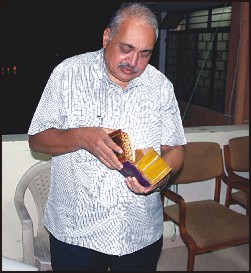
By Dr. K. Javeed Nayeem, MD
Late last night I had the good fortune of holding in my hands, albeit momentarily, a gold-leaved copy of the Holy Quran from a bygone era that had been seized recently by the Mysuru district Police when attempts were being made by some persons to sell it for a sum of rupees five crores. It all started with a late night phone call from my close friend A.G. Murali, who wanted to know if I had on hand someone who could read Arabic.
When I said that I could do it myself although I could not claim to have a scholarly knowledge of the language, he asked me if I could come down to the office of the DySP of Mysuru rural district. Sensing that I was puzzled by such an unusual request at such an odd time, he explained to me that the Police officers there were examining the recently seized Quran and were keen to know a little more about the book.
Excited by the request, I hurried to the place with my cousin Adil Pasha and my camera, sensing a rare opportunity to see and photograph the rare find. Most often I go looking far and wide for a subject to write about in my column and only once in blue moon a subject comes looking for me and here was one such Godsend!
After meeting the DySP Dr. Vikram Amte, when I eagerly asked him where the book was he smiled and pointed to an almost cubical object placed on the table right before him. Because of its unusual dimensions, I could not immediately recognise it as a book which I expected would be flat and broad as most books are. It was almost as thick as it was broad because its 302 sheets were unusually thick, being gold plated and inter-leaved with butter paper to preserve them. The rich black ink stood out against the golden background, the shine of which seemed to be without the slightest loss over the centuries. Printed on both sides of each sheet, the book has 604 hand-written pages, the text of which is very readable with the naked eye. The title page has the name ‘Al Quran Al Kareem’ like most other Qurans but on the last page is an unusual inscription; ‘Buzargaane Rava’ which the noted historian, Dr. B. Sheik Ali, after examining the book, has interpreted as a dedication of the labour of love by its calligraphers to contemporary saints. He has also said that going by the date AH 1050 on it which translates to 1605AD of the Gregorian calendar the book seems to have been crafted at the time when Emperor Jahangir ascended the throne. This was a time when hand-written calligraphy was at its pinnacle in the Moghul court.
Incidentally, the Islamic lunar year is eleven days shorter than the solar year which we follow and, therefore, an Islamic century is equal to 97 solar years. The present year of the Islamic calendar is 1436 Hijri. A book on calligraphy which I have says that the word which means ‘beautiful writing’ is derived from the Arabic and Persian word ‘Qalam’ which means pen.
Although calligraphy exists in almost every other language too, it is in the Arabic script that it has almost become an art form. The present artifact which has now passed perhaps from the Moghul court to the custody of the law court will perhaps pass on to the desk of the archaeologists who will verify its authenticity. And, if it confirmed to be a genuine antique really from an era of which it bears the date, it will perhaps go down in history as the biggest catch of our district Police led by our young and dynamic SP Abhinav Khare. The team deployed by him to tactfully nab the persons trying to sell it consisted of Dr. Vikram Amte, Dy.SP, Mysuru Rural Sub-Division; Inspectors D. Ashok, Mysuru South, Siddaiah, K.R. Nagar, Gopala Krishna, DCIB, Sub-Inspectors Gangadhar, Saligrama, Poonacha, DCIB and Police constables Bhaskar, Anand, Ravi, Zahoor and Pachche Gowda.
It appears the BBC channel has been trying to contact our district Police for details of their find. While it is now only the small fry that are in the Police net the actual owner has not yet been traced although evidence points to a source somewhere in the Hyderabad region which is again a prominent seat of royalty and, therefore, a well-known source of royal antiques. If this relic had found its way to the international market, it would perhaps have gone under the hammer for a price that would perhaps have made the whopping sum of five crores it was being peddled here for seem like a mere pittance!
e-mail: kjnmysore@rediffmail.com
source: http://www.starofmysore.com / Star of Mysore / Home> Feature Articles / Friday – August 14th, 2015








